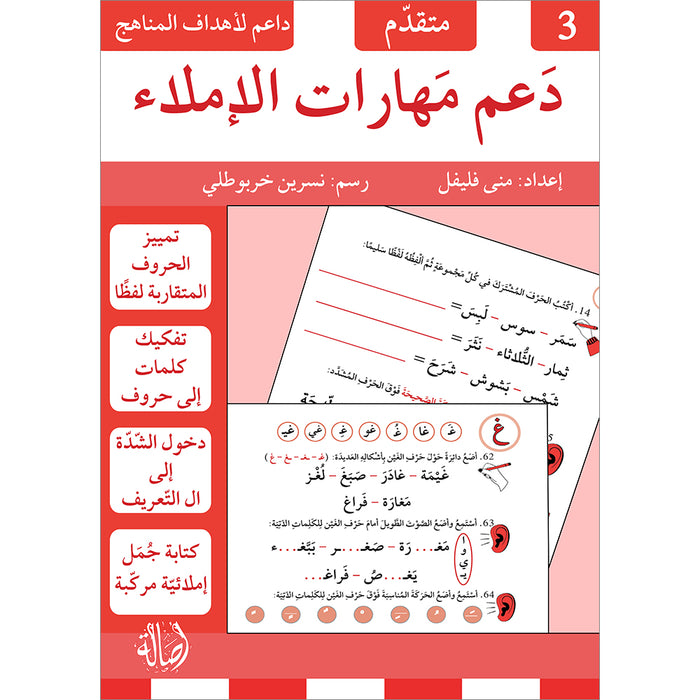Assistant Guide for the Series "Supporting Spelling Skills"
The third book, which falls under the advanced level, includes the following letters (ص - ث - ي - ط - ض - ظ - ذ - غ). These letters are, of course, the least frequent in children's words and resemble others either in writing or pronunciation.
The third and final book of "Supporting Spelling Skills" for the advanced level focuses on less frequent letters in children's words, which resemble others in writing or pronunciation as I mentioned earlier. In this book, I have concentrated on the concept of the "shadda" (gemination) through several exercises that are graded across different levels and advanced patterns. It is important here that the teacher or educator first pronounces the words correctly and serves as a role model for the learner.
I have also included words such as "ثمار" (fruits) and then "الثمار" (the fruits), "طرقات" (roads) and "الطرقات" (the roads), etc. The skill of breaking down words into letters, which includes the letter with "shadda," is first practiced by following the example in the exercise and then independently without following a specific example. The third book/advanced level also features exercises involving letters that are phonetically similar. It is important to engage the learner in pronouncing these letters correctly and in positioning the tongue for accurate pronunciation.
For example, the letter "ذ" (dhāl) requires the tip of the tongue to be placed between the upper teeth, while the letter "س" (sīn) is pronounced with the tongue behind the teeth without protruding. The letter "ظ" (ẓā) is pronounced like "ذ" (dhāl) but with emphasis. The letter "غ" (ghayn) originates from the bottom of the throat (closest to the mouth), while "ط" (ṭā) is an emphatic version of "ت" (tā) pronounced with the tongue's tip, and "ض" (ḍād) is pronounced with the tongue down and the sound coming from its tip.
In this book, learners above the age of six, meaning seven years and above, according to curriculum standards, will be able to complete complex spelling sentences. The total number of new words in the third book, composed of these phonetically precise letters, is 48 words (including 8 repeated words with the definite article "ال" added to them). As previously mentioned, this simplifies the concept of the "shadda" at the beginning of spelling skills in primary grades.
Therefore, the learner becomes capable of mastering advanced and suitable concepts with their overall maturity, typically at the age of seven and above (or in the second primary grade). They can achieve a greater goal of writing compound sentences containing less frequent and phonetically similar letters as mentioned in the third book of "Level 3 / Advanced" according to the curricula. Thus, they become able to pronounce them correctly and better than before, mature enough to comprehend deeper concepts.
دليل مساعِد لسلسلة «دعم مهارات الإملاء»
الكتاب الثّالث الّذي يندرج تحت مستوى متقدّم يتضمّن هذه الحروف (ص- ث – ي – ط – ض – ظ – ذ – غ)، وهي بالطّبع الحروف الأقلّ تواترًا في كلمات الأطفال وتتشابه مع غيرها إنْ كتابةً أو لفظًا.
الكتاب الثّالث والأخير من «دعم مهارات الإملاء» للمستوى متقدّم، فيرتكز على حروف أقلّ تواترًا في كلمات الأطفال وتتشابه مع غيرها إن كتابةً أو لفظًا كما ذكرتُ في الأوّل. وقد ركّزْتُ في هذا الكتاب على مفهوم الشّدّة من خلال تمارين عدّة متدرّجة في مستويات مختلفة وأنماط متطوِّرة. ومنَ المهمّ هنا سلامة النُّطق في الكلمات من قِبَل الأُستاذ أو المُربّي أوّلًا، وليكن قدوةً للمتعلّم ثانيًا. كما وعملتُ على وضع الكلمة عيْنها مثل «ثمار» ومن ثمّ «الثّمار»، «طرقات» «الطّرقات»... إلخ.
كما ومهارة تفكيك الكلمات إلى حروف والّتي تتضمّن حرف الشّدّة من خلال اتّباع المثال للتّمرين أوّلًا، ومن ثمّ العمل تلقائيًّا من دون اتّباع مثالٍ معيّنٍ.
كما انفرد الكتاب الثّالث/ متوسّط بتمارين تتضمّن الحروف المتقاربة لفظًا. ومن المهمّ مشاركة المتعلّم في كيفيّة لفظ تلك الحروف وكيفيّة وضع اللّسان للفظٍ سليمٍ للحرف. على سبيل المثال، حرف الذّال [ذ] يوضع طرف اللّسان إلى الأعلى ومن بين الأسنان، حرف السّين [س] من بين الأسنان من دون خروج اللّسان، حرف الظّاء [ظ] مثل حرف الذّال[ذ] إنّما مع تضخيمه، حرف الغين [غ] ينبع من أدنى الحلق (أي أقربه للفم)، حرف الطّاء [ط] تضخيمه عن حرف التّاء [ت] ومن طرف اللّسان، وحرف الضّاد [ض] يكون اللّسان إلى الأسفل وخروج نُطْق الحرف من رأسه.
وفي هذا الكتاب أيضًا سيتمكّن المتعلّم ما فوق سنّ السّتّ سنوات أي السّابعة وما فوق وفقَ معايير المناهج من إتمام جملٍ إملائيّةٍ مركَّبةٍ. إذ مجموع الكلمات الجديدة في الكتاب الثّالث المكوَّن من تلك الحروف الدّقيقة لفظًا: 48 كلمة (ومن ضمنها 8 كلمات مكرّرة، إنّما دخل عليها ال التّعريف). وذلك كما ذكرت مُسبقًا، لتسهيل مفهوم الشّدّة في بداية مهارات الإملاء منَ الصّفوف الابتدائيّة.
بالتّالي بات المتعلّم قادرًا على إتمام مفاهيم متطورّةٍ ومناسِبةٍ مع نضجه بالمجمل أي وهو في سنّ السّابعة وما فوق (أو في الصّفّ الثّاني الأساسيّ). وأصبح بإمكانه أن يحقّق هدفًا أكبر ألا وهو كتابة جملٍ مركّبة تتضمّن حروفًا أقلّ تواترًا، كما ومتشابهةً لفظًا كما وردت في الكتاب الثّالث من «المستوى 3 / متقدّم» وبحسب المناهج. وبالتّالي، بات قادرًا على التّمكّن من لفظها بشكلٍ سليمٍ وأفضل من قبل، وصار ناضجًا ومتمكّنًا لاستيعاب مفاهيم أعمق.
























